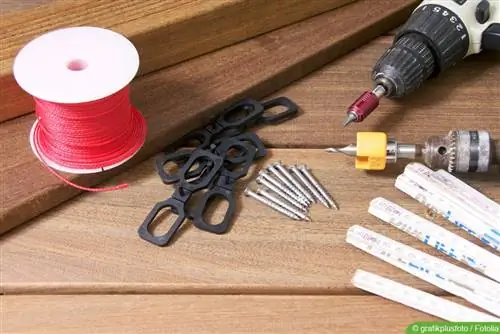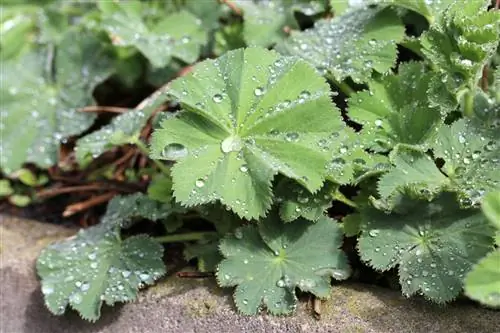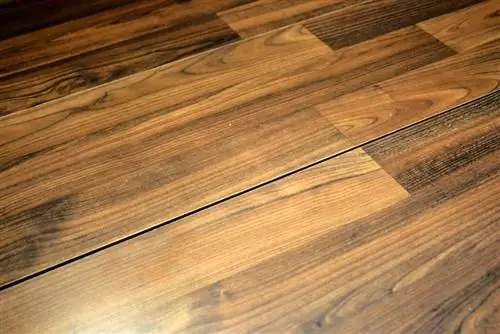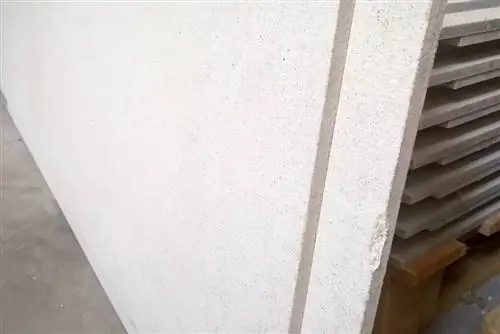- Author admin [email protected].
- Public 2023-12-17 03:39.
- Last modified 2025-01-24 12:45.
Bankirai appears in Europe under many different spellings: Bangkirai, Bankirei or Bangkirei - everything is possible. However, this always means the same tropical wood from Southeast Asia, which is obtained from the Philippines to Java for the international market. It is characterized above all by its hardness, its weather resistance and its attractive appearance. It is therefore ideal for outdoor floor coverings.
Type of wood
Bankirai belongs to the genus Shorea, which is mainly found in Southeast Asia. Its botanical name is Shorea spp. Because of its hardness, it is primarily used for outdoor construction. For example, it is used for switch sleepers, noise barriers and Weiberg piles. However, it is now most commonly used for substructures and decking on terraces. In addition to the particular hardness of the wood, the fact that this species is particularly resistant to fungi, termites and, in general, insects also plays a role. However, the hardness of the material also means that the wood is very difficult to work with. For example, screwing only works if drill holes have been drilled beforehand. Gluing is almost impossible because it has a very high shrinkage tension.
Tip:
Shorea spp. is a tropical wood and can therefore also come from the deforestation of rainforests. When purchasing, you should therefore make sure that the wood on offer has the FSC seal for sustainable forestry.
Laying the substructure
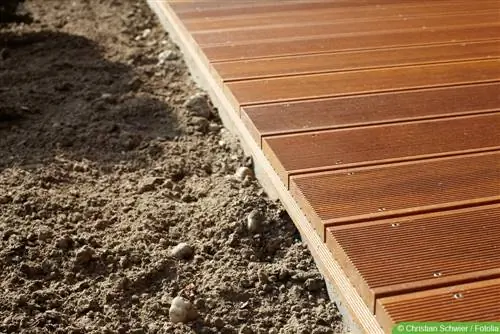
In order to lay Bankiraid floorboards, you first need a suitable substructure. If possible, this should also be made of hardwood. If the substructure is placed directly on the ground, a so-called root fleece is recommended as a base, which helps to contain the growth of weeds. However, it makes more sense and is more sustainable than this approach to lay the substructure on floor slabs. If there is already a concrete terrace, the construction can of course be installed there directly. A framework made of supporting timbers that are screwed together is used. Here is a short guide:
- first position the supporting timbers on the ground
- the distances between them should be 50 to 60 centimeters
- border the longitudinal timbers flush with a cross timber at each edge
- screw the resulting grid together
- screw the entire grid to the substrate
- Use dowel screws when screwing to the substrate
The grid construction should be firmly connected to the surface and not be able to move. It is always important to keep in mind that the terrace is intended to be used and that forces inevitably act on it. Slipping of the substructure can lead to unpleasant accidents.
Note:
With a concrete surface, you don't necessarily need a substructure. Here the bankiraid boards can also be screwed directly to the floor.
Laying floorboards
Once the substructure is finished and attached to the floor, you can start laying the individual floorboards. These are first laid out again over the entire area. It makes sense to start at the wall of the house and work from there in the opposite direction. Of course, the planks must already be cut to the correct length. It is best to have this done at the specialist store where the material was purchased. This saves a lot of time and effort. Here are a few instructions for laying the floorboards:
- Distance from the first floorboard to the house wall: one centimeter
- Distance or joints between the planks: three to five millimeters
- Pre-drill screw holes
- two screw holes for each supporting timber on which the plank rests
- keep at least two centimeters of distance from the ends of the boards
- all screw holes must be in a line
- Don't start screwing until all the holes have been drilled
- screw tight
When selecting screws and drills, you should definitely seek advice from a specialist retailer. The screws must be galvanized and corrosion-resistant. In addition, it is recommended to always work in pairs. To ensure that the drill holes actually fit, each plank should be held by a second person. It is important to avoid slipping. The three edges are then covered with a panel. This can be made of plastic or Bankirai wood.
Care
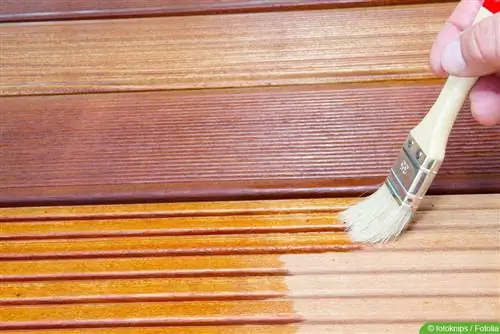
One of the advantages of Bankirai or Bangkirai is the fact that it basically requires little or no care. However, for visual reasons, it is advisable to schedule a maintenance measure once a year. This allows the warm color of the wood to be preserved. Proper care also prevents the floorboards from turning gray over time. So here are a few instructions for annual care:
- First clean the floorboards well to remove any coarse dirt
- use a brush and cold water
- the entire surface can be wet
- then apply the so-called wood degreying agent over the entire area with a brush
- Let it take effect for around ten minutes
- then brush vigorously
- always brush in the direction of the grain
- rinse with plenty of water after brushing
- let dry
- Finally apply Bankirai oil and let it dry
The degreying agent and the care oil are usually easily available from specialist retailers. The amount required depends on the size of the terrace or balcony.
Note:
The manufacturer's instructions apply to each care product. These may differ from the procedure described above.
Criticism
Admittedly, Bankirai is very difficult to beat in terms of durability and looks. However, the question arises as to whether it necessarily has to be tropical wood that you use to cover your terrace floor. Even if there is an FSC certificate, the material still has a long journey before it ends up with us. There is no lack of environmental impact. In addition, there are very few offers in hardware stores and wood specialist stores that can actually bear the FSC seal. Against this background, a carefully considered consideration should definitely take place. An excellent alternative to Shorea spp. By the way, it is Douglas fir. This wood definitely comes from Europe and is therefore not dependent on long transport routes. In addition, Douglas fir offers with an FSC seal are much easier and more common to find. And this wood is also a little cheaper.

